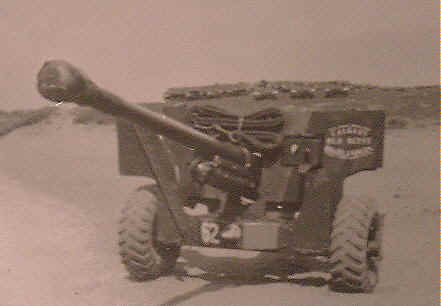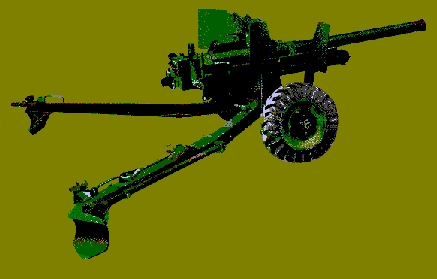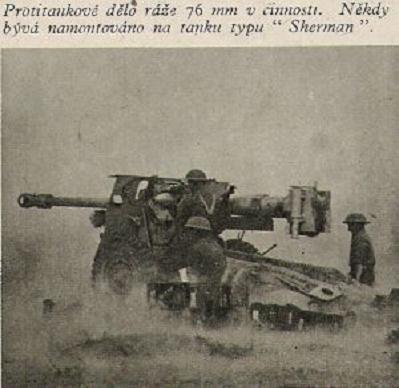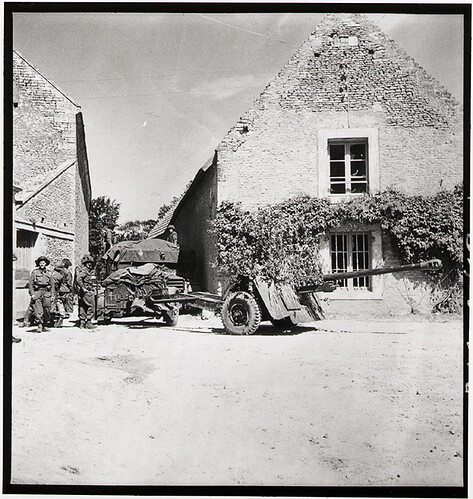Check out those victory rings!
I never noticed that until you brought it up, Sickles. Interesting! I read some of the comments below that photo…some people said that these “rings” were added even though they may not have gotten a kill?
Check out the fact that the MP-40 that guy is holding doesnt have a hand grip.
Or when they were swatting mosquitoes. The bloodsucking kind…
For the British tank crews the odds against survival were alarmingly shortened by the range and accuracy of the German 88’s, and there was considerable resentment within the Eighth Army at the failure of their superiors to give them a comparable weapon, which many believed was already at hand if only the general staff had the wit to adapt it and press it into service. This was the British 3.7" (94mm) anti-aircraft gun, and Lieutenant David Parry of the 57th Light anti-aircraft Regiment, Royal Artillery felt there was ‘no excuse for the stupidity of the General Staff’ in not allowing it to be used in an anti-tank role.
He later recalled in a memoir: ‘During all this time over a thousand 3.7" AA guns stood idle in the Middle East…Many never fired a shot in anger during the whole of the war.’
Three times I’ve noticed in various books remarks about British commanders ordering the 3.7" AAA guns deployed to repel armored attacks. The earliest refrence was for the Salerno landing. The 3.7 regiment was ordered to take up suitable positions, but the German attack did not reach the line of sight of the batterys. The second case was at Anzio, where again the German attack did not reach the field of fire of the guns and after a couple days they were returned to the AA positions. Last was a remark about the Brit Army using them in Normandy in their AT defense. All these were breif sentences in second hand sources. Still they suggest something was learned from the desert war.
Yes. I haven’t seen those references, but I would imagine that the ones at Salerno probably began their careers in Egypt. Much was learned by both British and American commanders in North Africa.
It is easy to criticize with hindsight - I know, as I do it constantly - but when one considers the 2 pounders and 37mm guns (both turret mounted and anti-tank), they were first designed for the European theatre, and, arguabley, much of the pre-war planning of the allies for the European theatre, was based on the experiences of W.W.1.
The 88mm had been designed as an A.A. gun, again for the European theatre. I would imagine that the British considered the Bedu as being the most likely threat in North Africa, until Il Duci began throwing his weight about, that is. Anyway, to some extent, the 2 pounder would have probably sufficed against much of what it would have been up against in the 1930’s.
Anyone that has experience of desert, steppe or prairie will probably have experienced what it is like to shoot a rifle or machine-gun at a target which appears well within range, only to see the tracers burn out well before they have completed describing their trajectory. The Western Desert was a vast flat expanse (not many crescent-shaped, rolling dunes, at all), which by its sheer size rendered the earlier British and American guns impotent.
" Furthermore, we learned that our anti-tank platoon of six 2 pounder guns were knocked out before firing a shot!.. "
What’s even more inexcusable is that the weapon was actually developed into a 96mm “32 Pounder” and fitted to that assault gun that never went anywhere…
But my source basically stated that the gun should have been fitted to a proper tank, “and there was no reason why it shouldn’t have been…(as it) would have been a world beater.”
Here’s a link:
Anti-tank capability
The 3.7-inch gun was never used as an anti-tank weapon, except in one or two emergencies. This is in contrast to the German Army, which integrated their equivalent “88” into anti-tank defensive screens from 1940 onwards.This was mainly because the 3.7-inch gun mobile mounting was almost twice as heavy as the German “88”. Redeploying it was a slower operation, and the heavy AEC Matador tractor normally used for towing could operate on hard surfaces only. Additionally, heavy AA Regiments equipped with the 3.7-inch gun were controlled by Corps or Army HQ, or at even higher level HQ’s, and command of them was not often devolved to the commanders at Divisional levels where the anti-tank role might be required. Prolonged firing at low elevations (not part of the original specification) also strained the mounting and recuperating gear.
The gun was used as the basis for the Tortoise assault tank’s 32-pounder anti-tank gun, but this tank, which could be described as a self-propelled gun, never saw service.
Nitpick - the calibre was 94mm. The 32 pdr was initially developed as a towed anti-tank gun, but it was absolutely massive so it made sense to put it into the Tortoise SPG, which was more or less the equivalent of the Jagdtiger.
But my source basically stated that the gun should have been fitted to a proper tank, “and there was no reason why it shouldn’t have been…(as it) would have been a world beater.”
Then your source hasn’t tried looking at the size of the gun and ammunition, and comparing them with the room in the turret of even the Centurion, the largest British tank made in WW2. It was tough enough even fitting the 17 pdr gun into British tanks (the Comet couldn’t manage it, hence the 77mm gun) and the 32 pdr was much bigger.
After WW2, the Centurion was upgunned to first 20 pdr (83.5mm) and in the mid-50s to 105mm, but these guns and their ammunition were specially designed for installing in a tank, and were more compact than the 32 pdr.
Of course, the Conqueror was a big bugger. Arriving on the scene post-war.
IIRC the power-pack was to light?
http://homepage.mac.com/michaelpiggott/militarymodels/Conqueror/Conquerormain.htm
I’ll get back to you on this. I’m pretty sure my source claims 96mm, but there are other typographical errors in it…
Hungry Aussies storming cookhouse for some tucker.
http://en.wikipedia.org/wiki/Image:El_Alamein_1942_-_British_infantry.jpg#file
"Anti-tank weapons
The Africa Corps did enjoy a qualitative superiority over the Allies when it came to antitank weapons, though mainly because they used a Flak gun in the antitank role. During the British offensives Brevity and Battleaxe in May and June 1941, for example, the standard German 37mm Antitank Gun 35/36 (37mm Pak 35/36) proved ineffective against the heavier British tanks; even the newer 50mm Antitank Gun 38 (50mm Pak 38) remained inadequate against the heavy British Matilda tank except at close range. It was here that the German 88mm Antiaircraft G 18 (88mm Flak 18) and its modified versions, the 88mm Flak 36 and 37, proved their tactical worth deployed in a ground role. The 88mm gun proved capable of penetrating even the British Matilda tank’s 3-in. (77-mm) frontal armor at ranges of up to 6,564 ft (2,000 m). The antitank capabilities of the dual-capability 88mm Flak gun, along with the tactical skill and professionalism of the German troops, made up for the fact that during Brevity and Battleaxe Rommel’s forces fought at a serious disadvantage in terms of armor (German commanders were always at a loss to explain why the British did not use their 3.7in. antiaircraft guns in the antitank role).
88mm Flak guns
At the Battle of Gazala, it was the few 88mm Flak guns that Rommel possessed that remained largely responsible for the high enemy tank casualty rates. The recent replacement of the British antitank gun arsenal with the 57mm six-pounder gun, which was superior to the German 50mm Pak 38 antitank piece, however, gave the Allies a tactical edge in the antiarmor struggle that went some way to offset the antitank killing power of the 88mm Flak gun. This development - coupled with the frontal invulnerability of the British Matilda II to the 50mm Pak 40 antitank gun - led Hitler in May 1942 to rush a new mobile antitank vehicle to the theater. The Tank-Hunter 38(t) Marten III (Panzerjöger 38(t) Marder III) mounted the potent ex-Soviet 76.2mm Pak 36(r) antitank gun in an open three-sided shield on top of the chassis of the obsolescent Panzer 38(t) tank. During the Battle of Gazala, the Marder III provided Rommel’s infantry with desperately needed mobile killing power to augment that provided by the small numbers of 88mm Flak guns available. The vehicle demonstrated the lethality of its 76.2mm gun by knocking out several dozen British tanks. Indeed, so impressed were Commonwealth troops that they assumed the Germans had simply mounted their potent 88mm Flak guns on fully tracked chassis."
My idea of having more Firefly Shermans, would ofcourse leave room for extra sherman 105s, with HEAT rounds that took care of quite fiew of the German armour when firing at the flanks, as usually the Shermans did try to do in Battle, or at least the Brit Shermans would go for the ‘split attack’, where it was usually a ‘two left, two right fast’! Kind of op, with one perhaps staying ahead and firing smoke and/or trying a lucky shot from ahead (Canada’s top tank ace in Normandy, Bradley Walters realized that the frontal armour of the Panther gun mantlet was a semi circle, so he figured that if he hit the lower third of the guns armour, the shell could only bounce down, toward the pretty thin upper armour of the hull, and result in probable wounds or death to either one or both of the two crew members sitting just under the beginning of the barrel, and if the driver was out of action, it resulted easily in the crew bailing out)…
He actually was able to hit this circa three feet wide and one foot high target from as far as 800 yards away and result in a kill/abandoned tank!
I remember a completely separate story from the German side that I read years ago, where one of the complaints that came with the crews in the Panthers, was what they thought was just accidental richoset’s killing their drivers and/or radio men from hits onto the lower portion of the gun shield!
And this from ‘regurlar’ Shermans! And T-34s…
Anyway, I veered off to some of the tactics and some of the most tactically savvy and lucky tank crews of the allied side. Brad Walters said that when attacking along the feared Verrier ridge in Normandy, he would come back walking! Meaning ofcourse that they were lucky in getting out many times when hit by the well hidden AT and armour…
But the ‘two and two split’, did work, one has only to go to the war museum in London to see the Jagdpanther, wich was a victim of such tactics, with a British ‘normal’ Sherman getting onto it’s left side, and shooting five or six rounds through the thin side armour…
Anyway, once the US Model 26 tank and the British Comet tanks came along, the Germans had squandered what they had in the west into the Ardennes battle, and very fiew tank vs tank actions were seen after January 45 in the west…
Still, the 17 pounder had it’s merits in it’s SABOT rounds, as the grandfather of modern tank guns… Not to say that the Germans, US and Russians werent there in the end of the war. All were firing pretty hard pressure rounds fast! As 32Bravo pointed out, the ‘early’ war at and tank guns were pretty puny, a circa 40mm gun being the norm… Ofcourse the Russian front changed this fast, as the Germans had to face T-34, KV1 and separate AT guns all firing the feared ‘ratchbum’! Meaning the best at/tank gun in 41, the Soviet 76mm gun! It was so good, that captured versions were mounted on a fiew hundred german Marder’s from 42 onward, and were equated as being on par with the early long 75mm guns of German origin, I cannot remember totally the variants but the long 75 had about three of the ‘normal’ long gun, something like 75mm something /pak39, pak40 and pak48. Then came the awesome pak70, which was very straight, long range and leathal!!!
And saw action in the Panther and Jadpanzer IV, when they were ready, earlier models of the Jagdpanzer IV had to do with probably a 75mm / pak48… Which could take out a Sherman from quite a distance! Only the late heavy Sherman, and the Tank model 26, and the British Churchill were immune to the shorter long 75mm guns, on the Panzer IVs, Sturmgeschuz III, IVs, early jadpanzer IVs, Hezers and some soviet 76mm guns along with german pak40 or pak 39 75mm(wasnt it? Well, you can check on this site if you want to and dont know it already, if not it’s a goldmine for German panzer info! Here, - http://www.achtungpanzer.com/profiles.htm ) on Marders II and IIIs.
Infact, nowadays a NATO standard 120mm gun, will stand about 500 shots and then you need to replace it, interestingly the ones in the seventies made T-72s, could only fire about 150! Maybe 200 if you were lucky, this means that the crews of say Iraqi, and also other nations T-72s, couldnt fire as much practice rounds as the NATO boys, a factor which tank crews say no simulator can replace in experience…
Anyway, I have seen so many impressive posts, that I lift my hat in admiration and thanks for the good info and great reads from all of you gents!
Yours truly, Mr Poundr.
I must say that I have seen a picture of a ww2 17pounder shell, that was a SABOT in theory, but it wasnt like nowadays where after ‘getting rid’ or the thick 120mm outer casings, the thin arrow SABOT which is probably about 40mm thick (guessing from the pictures), is solid DP uranium, or Tungsten…
But the one that I saw for the ww2 pounder, had a ‘regurlar metal’ body, with a cap, or very short condom if you will that was made of Tungsten.
Now I can surmise that the reason they did this was that they were aware of the ‘in and out’ quality of an all tungsten ‘arrow’, so they made this cap which would have separated after the initial penetration of the hull, and then ofcourse you had the steel after shell which was blunt, bouncing about, and also the tungten cap, which probaly wouldnt penetrate on itself, so it also would be doing what AT/tank shells did anyway sometimes, ie they started richoseting inside the tank, usually resulting in horrible trauma to the crew members…
If anybody knows of the ‘cap model sabot’, please let us know, I remember it clearly for I thought ‘what a devilish idea’ at the time!
ps, dont forget the six pounder which had experiments of sabot, and in theory was the first gun to fire sabot rounds, but I dont belive this took place in the battles it took place in…
still, for it’s size, it was a good anti tank gun, and the most numerous Panzer IIIs, and the tank killer variants from it, all had a healthy respect for the 6pounder/57mm(US term for same gun).
So I put pics of the 6 ‘n’ 17 pounder guns, so one can see the clear developement from where the 17 pounder came from…





WW2 British APDS ammunition used a blunt-nosed, solid tungsten-carbide penetrating core, contained within a close-fitting aerodynamic pointed sheath which also contained a tracer in the base, the whole being surrounded by the sabot until that broke up and fell away after leaving the muzzle.
The pic below (from the Ammunition Photo Gallery on my website) shows some WW2 sub-calibre AP projectiles. The 6pdr and 17pdr APDS projectiles are replicas, but the 17pdr APDS penetrating core is the genuine article (and is very heavy!).

I stil go for Acht punkt Acht
I read , i dont remember where , that 17pdr was the best AT gun in World War II . I also read that it was able to destroy any enemy tank from a distance more than 800m . Well the question
is that if it was able of that why dont we ‘‘heard’’ of any Tiger been knocked out from a hit in the front armour by a 17pdr gun ?
I don’t know if we can go that far, but it is without question that it was one of the best AT guns of WW2
. Well the question
is that if it was able of that why dont we ‘‘heard’’ of any Tiger been knocked out from a hit in the front armour by a 17pdr gun ?
We have 
The 17 pdr spoiled many a Tiger tank crews day
I’ve even “heard” of Tiger I’s being knocked out by a hit on the front armour by a 75mm shell from a normal Sherman 



